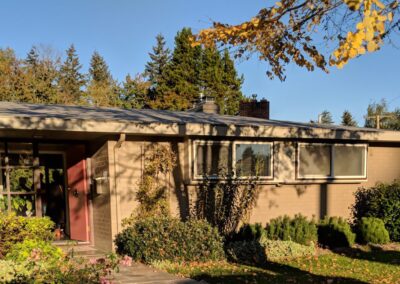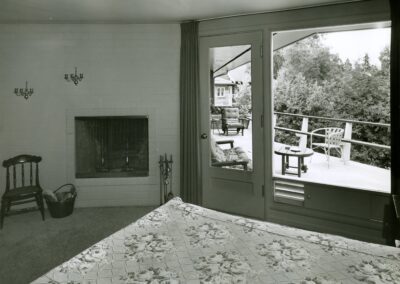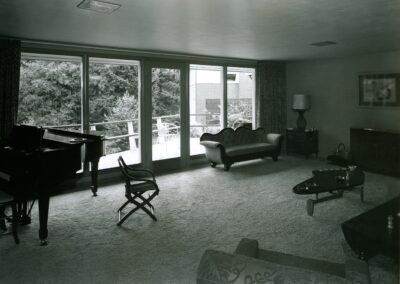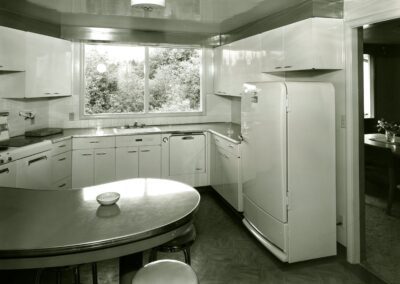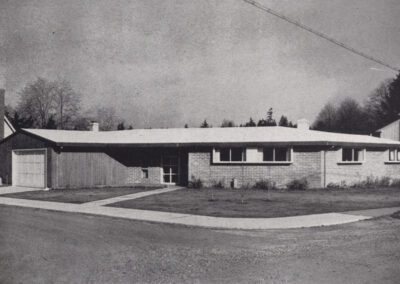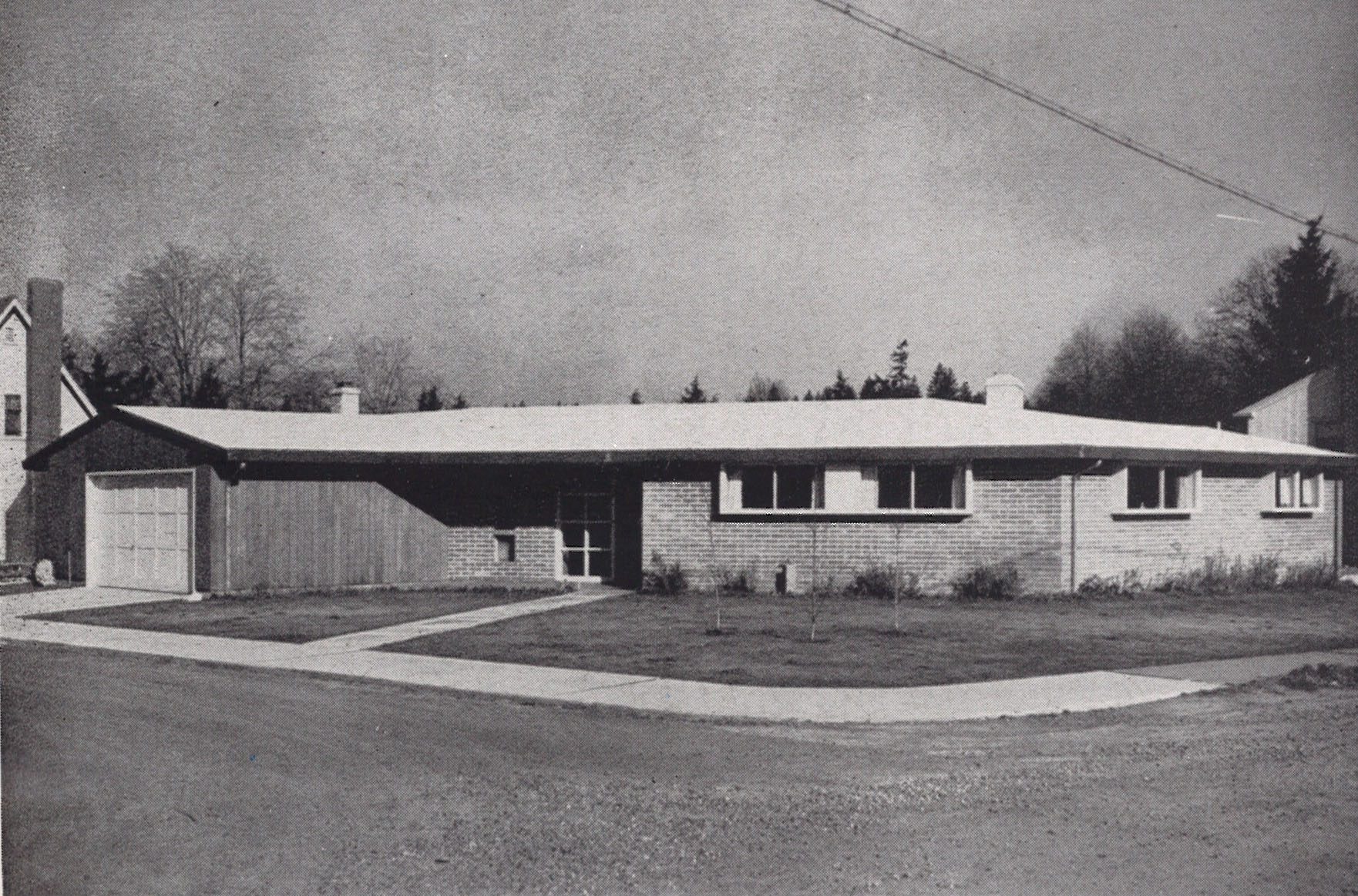
The Schmidt House
2932 Maringo Rd SE, Olympia WA, 98501
Built 1950
The Schmidt House was featured in a Docomomo US/WEWA home tour on October 13, 2018 (an event co-sponsored by the Olympia Tumwater Foundation). Text source: National Register of Historic Places nomination form (prepared by Lauren Danner); Docomomo US/WEWA.
The History
The Trueman and Virginia Schmidt house is a National Register-listed property located in Olympia’s Southeast neighborhood. Most houses in the area were constructed between 1920 and 1960, and a variety of architectural styles are represented. Built in 1950, the Schmidt house presents an outstanding picture of gracious living in Olympia, representing optimism in a new era. It is an example of high style residential construction after World War II, a time when building materials were in still short supply and the national economy and population were booming. In Washington State, the population jumped from 1.7 million in 1940 to 2.3 million in 1950, and to 3.1 million by 1970. In post-war Olympia, the population increased 19 percent from 1940 to 1950, and 16 percent from 1950 to 1960. New buildings were constructed throughout the city and reports of their progress was a common news item in The Daily Olympian. An earthquake in April 1949, while severe, further spurred the construction boom.
Capitalizing on the large demand for architectural designs during this time were a plethora of newly arrived young and eager architects who brought with them the latest architectural fashions and modes of thinking. The Schmidt house represents the work of Wohleb & Wohleb Architects and their associate Gordon Stacey Bennett. The firm and Bennett created many of the area’s notable mid-century buildings. Bennett is said to have designed the Schmidt house, one of his earliest works.
The Building
A one-story structure built into the rim of a glacial kettle that creates a daylight basement, the 3,260 sq. ft. house was constructed to take advantage of this challenging site. The design’s obtuse-angled “S” shape, with the back hugging the side of the slope, maximizes the tranquil greenbelt views. The large wood slab front entry door is in the middle of the “S” and opens to a foyer from which the living/dining room, bedroom wing, and kitchen/laundry wing may be accessed. The two banks of floor-to-ceiling windows next to the front door add a modern element to the main entry and contrast the horizontal ribbon windows of the bedrooms. The living room is anchored by a fireplace and built-in stereo cabinet. The center of this room was designed with a piano in mind and projects slightly out over the lower yard, delineating the dining room space from the rest of the room. The house possesses high artistic values, particularly the use of strong horizontal and vertical themes contrasted by the use of circles in interior ornamentation.
The house was built for Trueman Leopold “Bink” Schmidt (1913 – 1979). He was a grandson of Leopold Schmidt, the founder of the Olympia Brewing Company. Founded in 1896 as the Capital Brewing Company, Leopold’s company eventually owned at least five breweries in the Pacific Northwest and California. The renamed Olympia Brewing Company (1902) was famed for its Olympia Beer, with its trademark slogan “It’s the Water.” The company was run by Schmidt family members until it was sold to Pabst in 1983, and over the years the family became one of the most prominent in the Olympia area. Trueman (known by his nickname “Bink”) graduated from Olympia High School in 1932 and enrolled at Oregon State University, but the Depression and the uncertainty of the family business forced him to return home. In 1941, he married Virginia Aetzel (1915 – 2002) who came from a family with deep roots in Olympia. This marriage joined two prominent families of the region. After Trueman completed service in WWII, the Schmidts returned to Olympia and Bink worked at the brewery for the rest of his career. Since the end of Prohibition, the brewery had been expanding. New buildings began going up in the 1930s and more were added regularly through the 1960s. Perhaps reflecting the national economic expansion and optimism after the war, a building was added in 1949. As construction engineer and later superintendent of construction, Bink would have been heavily involved in expansion plans and building design decisions, which would have brought him into contact with Joseph and Robert Wohleb, the father and son principals of Wohleb & Wohleb Architects, and designers of the various brewery additions.
Bennett and the Schmidts created a post-war residence for a family of four that is extraordinary in its attention to detail and innovative for its time. Its cutting-edge details, many of which survive intact, included radiant heat, cork floors, one of the earliest dishwashers in Olympia, an intercom system, a sprinkler system, landscape lighting, a ventilation system that combined louvered screens with a whole-house fan, motorized drapes, an automatic coat closet light, and extra-thick walls in the main living area that muted sound in the bedroom wing. According to the third owner (in 2018), the house was considered a “showplace” when it was built.
The Architects: Wohleb & Wohleb
After arriving in Olympia in 1911 (from Vallejo, CA), Joseph Wohleb (1887 – 1958) became regionally famous as “Olympia’s architect” and responsible for several notable buildings, including several on the Capitol campus, the Thurston County Courthouse (1930), the Lord Mansion (1923), and the McCleary Mansion (1925).
Born and raised in Olympia, Robert H. Wohleb graduated from the University of Washington with a BA in architecture in 1939; and, in 1946, joined his father’s architectural firm. As time progressed, the young Wohleb began taking on an increasing role in the firm, and in 1949, the firm’s name was changed to Wohleb & Wohleb. After his father passed away in 1958, the firm name was changed to Robert H. Wohleb Associates. He found his niche by specializing in the design of breweries – including working with the Schmidts. Other notable projects include the State Theater (1949), St. Michael’s Catholic Church (1966), and Memorial Hospital (1948). His most noteworthy design however is Olympia City Hall (1966). In 1966, at the height of his career, Wohleb died suddenly at age 50, the result of a tragic boating accident.
Associate Gordon Bennett graduated from the Wentworth Institute in Boston with a degree in structural engineering in 1938. He began his formal architectural training at the University of Oregon in 1939. With his studies interrupted by the war, Bennett eventually graduated with a Bachelor’s degree in Architecture from the University of Oregon in 1946. Practical experience was gained by working with Victor Louis Wulff in Spokane, and then for the Wohleb firm during the summer months. Upon graduation, Bennett took a civil service job as an instructor at the engineering school at Geiger Field in Spokane (1946 – 1947) He then rejoined the Wohleb firm full time where he remained, rising to the level of associate. In 1961, Bennett opened his own independent practice. In 1962, Bennett formed a lasting partnership in Olympia with fellow architect, Steve Johnson. Together the firm of Bennett & Johnson had a profound impact on the built environment of Olympia in the second half of the 20th century.
The Schmidt House | Olympia
Built 1950 | Source: WA State Archives, Susan Paris Collection; Vibert Jeffers, photographer
The Schmidt House | Olympia
Built 1950 | Source: WA State Archives, Susan Paris Collection; Vibert Jeffers, photographer
The Schmidt House | Olympia
Built 1950 | Source: WA State Archives, Susan Paris Collection; Vibert Jeffers, photographer
